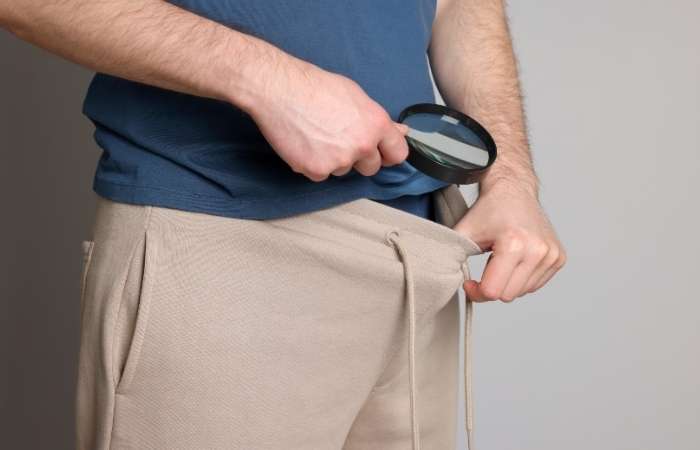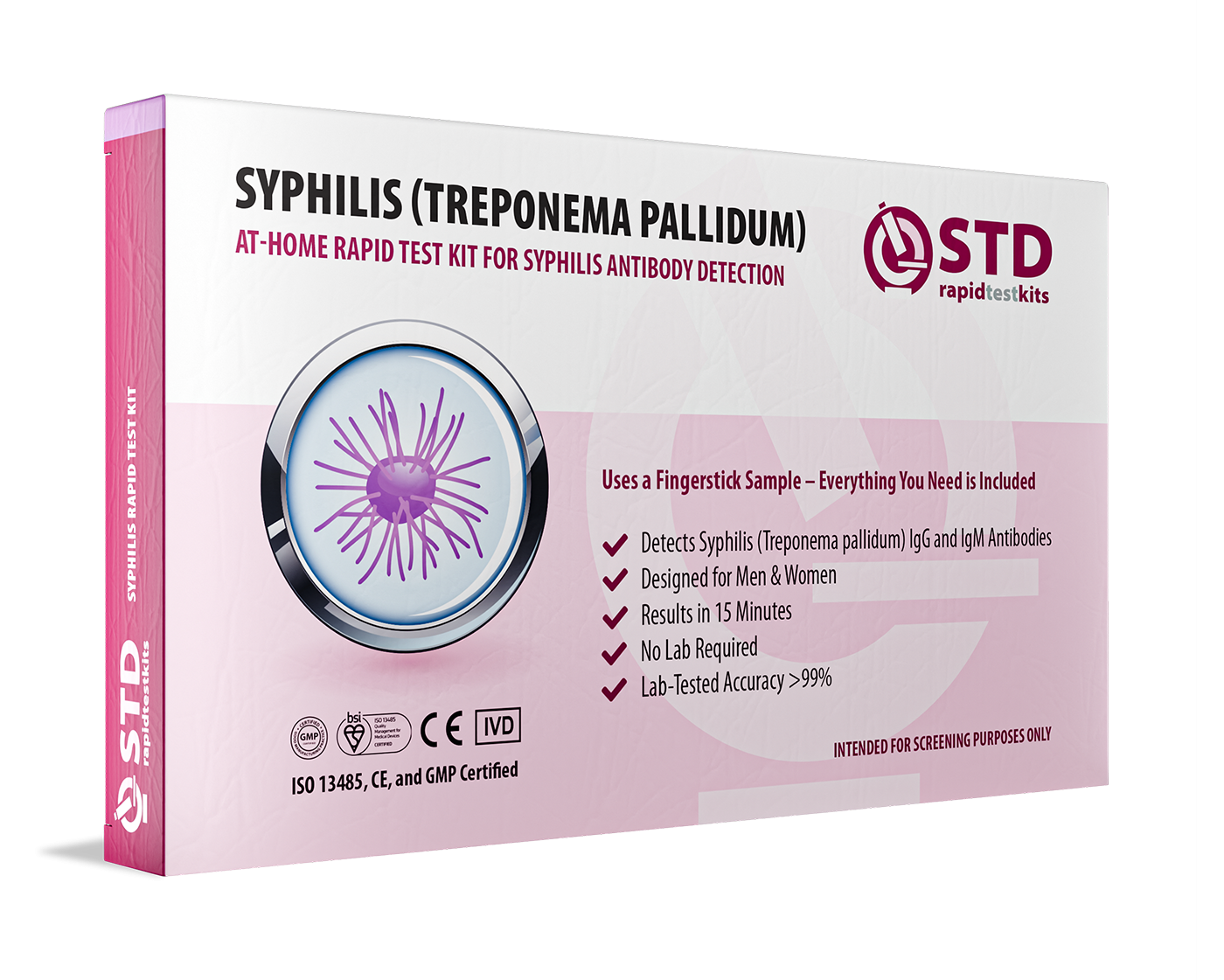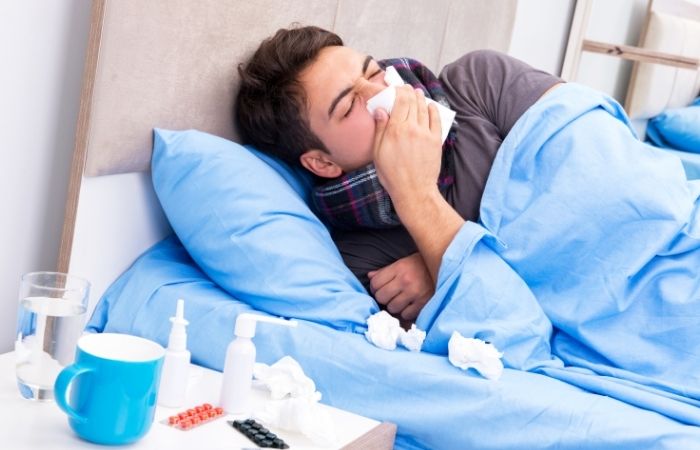Urethral Discharge & Light Burning, Not Always Front-Page News
If you’re noticing any dripping, even just a little cloudy discharge, or a hint of burning when you pee, that’s not “just last night’s beers.” It often signals urethritis, commonly caused by chlamydia or gonorrhea. The CDC confirms that men with these infections may experience urethral discharge, dysuria, or pruritus, though sometimes only diagnosed on exam.
Left unattended, what seemed mild can evolve into prostatitis, strictures, or epididymitis. A simple NAAT urine test, like those in home test kits, is up to the job. You’re not overreacting by testing; you’re staying ahead.

Other men are also reading: Penis Discharge and STDs: Early Signs You Shouldn’t Ignore
Slight Itch or Tingle, Don’t Let It Slide
An itch at the tip of your penis, tugging at your brain as “just dry skin”? It could be early trichomoniasis, herpes, or even HPV. (Yes, men can get HPV too) StatPearls notes urethral pruritis and dysuria are common early flags.
Guys shrug this off. But untreated, these infections hang around and hurt partners later. A herpes or HPV test is a smart check-in, man up, don’t hold back.
Throat Scratch After a Hookup? That’s Not Nothing
Thinking oral sex is harmless? Think again. Chlamydia, gonorrhea, syphilis, and HPV can invade your throat, and the CDC affirms asymptomatic oropharyngeal infections are alarmingly common.
A lingering sore throat, a white patch, or just a weird burnt feeling may be STD-related. Early oral STD detection helps avoid spreading to partners, plus some strains carry a risk of throat cancer.
Low‑Grade Aches & Fatigue: More Than Workout Soreness
Under-the-radar aches, lower abdomen, testicle niggles, and tailbone discomfort can be silent signs of urethral infection or even early syphilis. Mayo Clinic reports chlamydia can cause lower abdominal pain, testicular swelling, and back pain.
Don’t chalk it up to gym fatigue. Schedule a combo panel. These hush-hush clues aren't weakness; they're signals. Testing is ownership.
Check Your STD Status in Minutes
Test at Home with RemediumSyphilis Test Kit

 For Men & Women
For Men & Women Results in Minutes
Results in Minutes No Lab Needed
No Lab Needed Private & Discreet
Private & DiscreetOrder Now $33.99 $49.00
Rashes, Sores & Bumps: The Ones You Dismiss Too Quickly
A rogue bump, a scab that won’t heal, or a faint rash, it’s easy to blame friction or detergent. But these could be early signs of syphilis, herpes simplex, or HPV. One study in The Lancet Infectious Diseases found that up to 70% of early syphilis cases in men started as painless genital sores that were ignored.
If a spot hangs around for more than a few days, or comes back in the same spot, don’t shrug it off. Test to rule it out. Early detection means easier treatment and fewer long-term complications.
Flu‑Like Symptoms with No Obvious Cold
Ever feel like you’ve been hit by a truck, fatigue, fever, sore throat, but no sniffles or congestion? That could be acute HIV or hepatitis. According to the CDC, acute HIV infection often presents with fever, rash, and swollen lymph nodes about 2–4 weeks post-exposure.
This “mystery flu” could be a serious signal. A follow-up HIV test within a few weeks of unprotected sex could be a game-changer. Grab an HIV Rapid Test Kit to check your status fast. Catching it early puts you in control of treatment and transmission.

Other men are also reading: How Chlamydia Affects Men and Women Differently (and What to Do)
Emotional Gut‑Punch: Shame, Numbness & Avoidance
Let’s talk about the psychology of silence. Shame, anxiety, or “I’d rather pretend it’s not real” are common reactions after noticing symptoms, or even suspecting something’s off. A 2021 paper in BMC Psychology noted that men often delay STD testing due to stigma and fear.
But here’s the truth: avoiding the facts doesn’t protect you, it keeps you stuck. Testing is power. It’s saying, “I trust myself enough to face the truth.” It benefits you mentally, sexually, and relationally.
The Silent Danger: No Symptoms at All
You might feel totally fine, but that doesn’t mean everything is fine. The WHO estimates that half of chlamydia and gonorrhea cases in men are asymptomatic. That means hundreds of thousands of guys are walking around unaware, and spreading infections silently.
A routine Combo STD Home Test Kit can detect chlamydia, gonorrhea, and syphilis even when your body doesn’t give a hint. Making regular testing non-negotiable is how real men protect themselves and others.
Long-Term Consequences: When Silence Costs You
Ignoring an STD doesn’t make it go away, it can grow roots. Untreated chlamydia can scar your reproductive tract; chronic syphilis can damage your heart, brain, or nerves; persistent HPV can lead to warts or oropharyngeal cancer; and untreated HIV becomes full-blown AIDS. A 2022 Lancet study links undiagnosed STIs to long-term sexual dysfunction in men.
By the time symptoms peak, you may already be facing infertility, erectile challenges, or severe health issues. The safest, smartest move? Test early. Test regularly. Don’t let silence decide your future.
Why Men Miss the Signs: Cultural Blind Spots
Cultural conditioning teaches men to “tough it out,” “feel nothing,” or “not talk about that.” Harvard’s Men’s Health Review found that masculine norms can delay healthcare-seeking by weeks or months.
Ignoring small “annoyances” is celebrated until it backfires. Dismissing symptoms isn’t strong; it’s a risk. Shifting the narrative, testing, owning the outcome, and having the convo, that’s true courage.

Other men are also reading: Drunk Decisions: The Surprising Ways Alcohol Impacts Your Sexual Health
It’s Not Just About You: The Partner Connection
Your health affects everyone around you. STDs spread through unprotected oral, anal, and genital sex, often without you knowing. A 2020 WHO report states that asymptomatic people are responsible for most STI spread.
Testing isn’t just self-care; respect. It shows maturity, trustworthiness, and emotional intelligence. Real talk: being up-to-date with your status strengthens bonds and relationships.
Routine Screening: Scheduling Sexual Health
Treat testing like you do dental cleanings or physical checkups. The CDC recommends annual screening for sexually active men under 30, and more frequent testing if you have new or multiple partners.
Embed STD tests into your calendar: every six months, post-hookup, or post-breakup. Use combo kits to cover your bases. That’s how men stay ahead, and last longer, healthier, and stronger.
If You Test Positive: What Happens Next
Getting a positive result doesn’t ruin you, it helps you get the right care. Most bacterial STIs are curable with antibiotics. Chronic infections like herpes or HIV are manageable with care and medication.
The CDC reports successful treatment in over 90% of cases with therapy and follow-up. You’ll work with a healthcare provider, follow treatment steps, and then return to your life with a clean bill and renewed purpose.
Check Your STD Status in Minutes
Test at Home with Remedium7-in-1 STD Test Kit

 For Men & Women
For Men & Women Results in Minutes
Results in Minutes No Lab Needed
No Lab Needed Private & Discreet
Private & DiscreetOrder Now $129.00 $343.00
For all 7 tests
FAQs
1. Can I have an STD without feeling sick?
Yes. Many STDs like chlamydia and gonorrhea are asymptomatic in men, up to 50% don’t show symptoms but can still spread infections.
2. What does early HIV feel like in men?
Early HIV can feel like a flu, fever, fatigue, sore throat, swollen lymph nodes, and rash, typically 2–4 weeks after exposure.
3. Which STDs are most common in men?
Chlamydia, gonorrhea, HPV, and herpes are among the most common. Rates vary by age and sexual behavior.
4. Are home STD kits accurate?
Yes, FDA-approved home kits use lab-based testing methods like NAAT or blood analysis and are over 98% accurate when used correctly.
5. Can STD kits cover oral infections?
Some do, but not all. Multi-panel kits often include tests for oral chlamydia and gonorrhea, check kit specs carefully.
6. How often should men get tested?
At minimum annually for most men. Test every 3–6 months for those with new or multiple partners or high-risk behaviors.
7. Can STDs impact fertility?
Yes, untreated STDs like chlamydia and gonorrhea can cause epididymitis or block semen flow, affecting fertility in men.
8. Is it embarrassing to get tested?
Not at all. Testing is brave. It shows maturity, protects your partners, and secures your future.
9. How do I tell a partner I tested positive?
Be honest, direct, and caring. Say something like, “I got tested, and I’ve got some treatment scheduled, I want you to get checked too.” It shows integrity and respect.
10. What if I’m scared of the results?
That’s normal. But fear is not an excuse to freeze. Taking the test shows you care about your health and your partners. You’ve got this.
Own It, Then Test It
You now know what subtle signals matter, and why men who test regularly aren’t weak, they’re warriors. Ignoring symptoms, or pretending you’re fine, is a cultural trap that’s costing men health, confidence, and relationships.
Great news: taking action is simple, private, and powerful. When you test, you take control, of your future, your body, and your integrity.
Step into your strength. Protect yourself and those you care about. Your health is worth it, and it’s time to prove it.
Sources
1. WHO: Sexually Transmitted Infections
2. Mayo Clinic: STD Signs & Symptoms
3. Signs of STDs in men: Symptoms and when they appear – Medical News Today
4. Chlamydia symptoms in men: discharge, burning urination, swelling – CDC
5. What Men Need to Know About Silent STD Infections – Centers Urgent Care
6. STI symptoms in men: discharge, burning, sores – Urology Health










